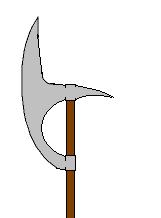1. a well developed thrusting tip for linear attacks
2. a long cutting edge for sweeping cuts, and higher hit probability
3. a good backspike for reaching over shields, also works wonders on "rhinos"
4. a long haft, 5 - 6 feet in length.
5. dont want the thing to get overly heavy, so I'll skeletonize the blade.
Once I drew the thing, I realized I wasn't looking at an axe at all, but a kind of bardiche. Now I'm wondering about the origin and history of the bardiche. I was under the impression this was an eastern European development, similar to the lochaber axe, but opposite end of the continent, used by Muscovites, Turks, etc? I'm not sure of the dates, either. www.aurorahistoryboutique.com says this:
| Quote: |
| The Sparth - or Bardiche was used throughout Scandinavia, Russia and Eastern Europe throughout the 16th and 17th centuries. At the time, this pole arm was known as the Bardiche. As the Bardiche has neither a lug or hook at the back, nor a spear like point ahead of the top of the haft, which makes it quite different from the halberd. Instead, the Bardiche blade is narrow and much longer than that of a halberd - with its upper part curving back above the end of the haft and being cut off square instead of drawing to a point. Although it seems fairly certain that the true bardiche of this form was not in use before 1500 A.D., there are numerous medieval manuscript pictures which show weapons of a very similar nature as early as 1250 A.D. |
is this accurate? I know polearms are a pain to categorize, as the y come in a dizzying array of shapes and functions, and many are just impracticle and ceremonial. One source says they were used as a monopod for harquebiusiers. Any how this is a very interesting weapon, can anyone illuminate the origins of the bardiche?
